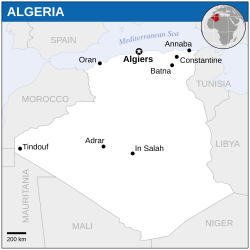More languages
More actions
| People's Democratic Republic of Algeria الجمهورية الجزائرية الديمقراطية الشعبية ⵜⴰⴳⴷⵓⴷⴰ ⵜⴰⵎⴳⴷⴰⵢⵜ ⵜⴰⵖⵔⴼⴰⵏⵜ ⵜⴰⴷⵣⴰⵢⵔⵉⵢⵜ République algérienne démocratique et populaire | |
|---|---|
Motto: "By the people and for the people" | |
 | |
| Capital and largest city | Algiers |
| Common languages | Arabic Berber French |
| Religion | 99% Sunni Islam 1% other |
| Demonym(s) | Algerian |
| Dominant mode of production | Capitalism |
| Government | Unitary semi-presidential republic under a dictatorship of the bourgeoisie |
• President | Abdelmadjid Tebboune |
• Prime Minister | Nadir Larbaoui |
| Area | |
• Total | 2,381,741 km² |
| Population | |
• 2022 estimate | 45,400,000 |
Algeria, officially the People's Democratic Republic of Algeria, is a country located in North Africa. It is the largest country on the Mediterranean sea, and the African continent as well as the tenth-largest country in the world in terms of land area. It is bordered by Tunisia in the northeast, Libya in the east, Niger in the southeast, Mali and Mauritania in the southwest, a few kilometers of the Moroccan-occupied Western Sahara in the southwest, Morocco in the west and northwest, and the Mediterranean Sea in the north.
Algeria is a member of the United Nations, African Union, OPEC and the Arab League. It also contributed towards the creation of the Maghreb Union. It was the home of Frantz Fanon, the famous anti-colonial writer.
History[edit | edit source]
Regency of Algiers[edit | edit source]
See main article: Regency of Algiers (1516–1830)
French colonization[edit | edit source]
France seized Algiers from the Ottoman Empire in 1830 and over the next four decades established its control over the rest of Algeria, making it a French colony. Slavery greatly expanded under the French occupation until its abolition in 1848.[1] The French locked two million Algerians in concentration camps.[2]:125
Independence struggle[edit | edit source]
In 1945, French paratroopers violently disbanded the Friends of Liberty and the Manifesto and killed tens of thousands of Algerians. The National Liberation Front (FLN) formed in 1954 following a counterattack on the French.[3]
Within three months, the population supported the independence movement. All Algerian political groups supported the FLN against the French, including liberals and communists. Between 300,000 and one million people died in the liberation war.[2]:119–20
FLN government[edit | edit source]
Algeria achieved independence in 1962 under its first president, FLN leader Ahmed Ben Bella. From July to September 1962, factions of the FLN fought against each other until Colonel Houari Boumédiène entered Algiers to back Ben Bella. The government imprisoned the leadership of the Communist Party and the Party of the Socialist Revolution. In 1963, Algeria adopted a constitution that banned all political parties except the FLN. Hocine Aït Ahmed began an insurrection against the government.[2]:123–24
In March 1963, Ben Bella's government passed a set of laws allowing workers to take any vacant property and manage it themselves. The peasants took over three million hectares of land abandoned by French farmers. He also banned speculation. However, he soon required farms to take credit from the state. The bureaucracy relied on the petty bourgeoisie and grew to 100,000 members by 1964.[2]:125–27
In 1964, after an assassination attempt against Ben Bella, the UGTA and UNFA began a series of strikes that led him to improve his relations with the Communist Party and trade unionists. Soon after Boumédiène broke into Ben Bella's house and arrested him. He continued the nationalization of industry (especially oil) but gave much more power to the military and national bourgeoisie and suppressed the UGTA and ACP. After Boumédiène died, Chadli Bendjedid ruled another military government until 1992.[2]:130–32
References[edit | edit source]
- ↑ Domenico Losurdo (2011). Liberalism: A Counter-History: 'Crisis of the English and American Models' (p. 157). [PDF] Verso. ISBN 9781844676934 [LG]
- ↑ 2.0 2.1 2.2 2.3 2.4 Vijay Prashad (2008). The Darker Nations: A People's History of the Third World: 'Algiers'. [PDF] The New Press. ISBN 9781595583420 [LG]
- ↑ Vijay Prashad (2008). The Darker Nations: A People's History of the Third World: 'Paris' (pp. 4–5). [PDF] The New Press. ISBN 9781595583420 [LG]


